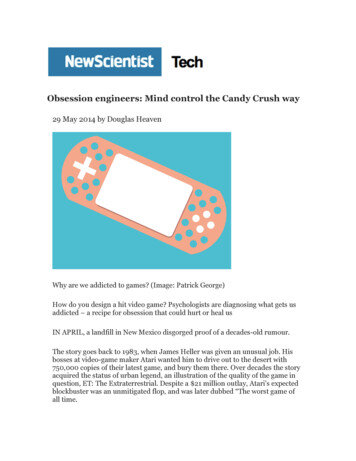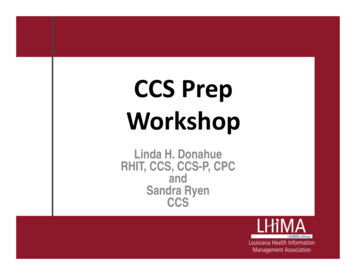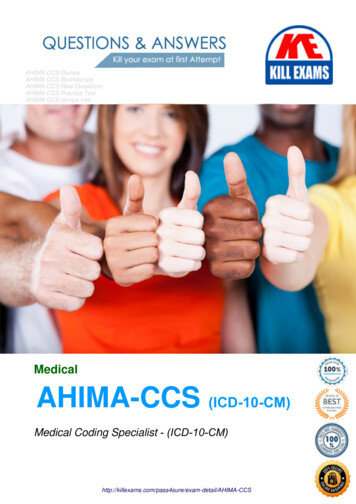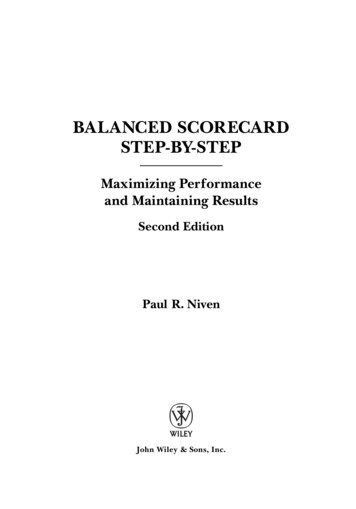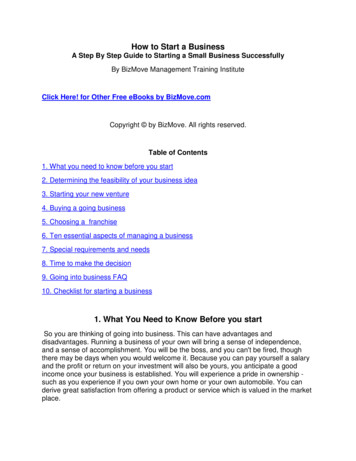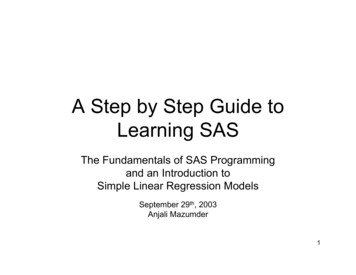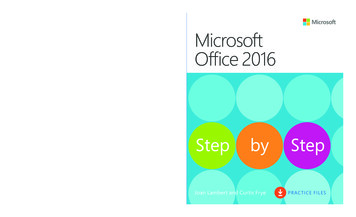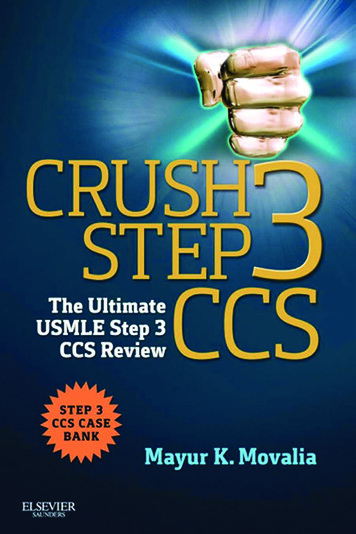
Transcription
Crush Step 3CCS: The UltimateUSMLE Step 3CCS Review
This page intentionally left blank
Crush Step 3CCS: The UltimateUSMLE Step 3CCS Review MAYUR K. MOVALIA, MDInternship, Internal MedicineUniversity of HawaiiHonolulu, HawaiiHematopathologistDahl-Chase Pathology AssociatesMedical Director, Flow Cytometry LaboratoryDahl-Chase Diagnostic ServicesMedical Director, Affiliated LaboratoriesEastern Maine Medical CenterBangor, MaineMedical Director, Cancer Care of Maine LaboratoryBrewer, MaineMedical Director, Mount Desert Island Hospital LaboratoryBar Harbor, MaineFaculty and InstructorUniversity of MaineOrono, Maine
1600 John F. Kennedy Blvd.Ste 1800Philadelphia, PA 19103-2899CRUSH STEP 3 CCS: THE ULTIMATE USMLESTEP 3 CCS REVIEW ISBN: 978-1-4557-2374-4Copyright 2013 by Saunders, an imprint of Elsevier Inc. All rights reserved.No part of this publication may be reproduced or transmitted in any form or by any means, electronicor mechanical, including photocopying, recording, or any information storage and retrieval system,without permission in writing from the publisher. Details on how to seek permission, further information about the Publisher’s permissions policies and our arrangements with organizations such asthe Copyright Clearance Center and the Copyright Licensing Agency, can be found at our website:www.elsevier.com/permissions.This book and the individual contributions contained in it are protected under copyright by the Publisher (other than as may be noted herein).NoticesKnowledge and best practice in this field are constantly changing. As new research and experiencebroaden our understanding, changes in research methods, professional practices, or medical treatment may become necessary.Practitioners and researchers must always rely on their own experience and knowledge in evaluating and using any information, methods, compounds, or experiments described herein. In usingsuch information or methods they should be mindful of their own safety and the safety of others,including parties for whom they have a professional responsibility.With respect to any drug or pharmaceutical products identified, readers are advised to check themost current information provided (i) on procedures featured or (ii) by the manufacturer of eachproduct to be administered, to verify the recommended dose or formula, the method and durationof administration, and contraindications. It is the responsibility of practitioners, relying on theirown experience and knowledge of their patients, to make diagnoses, to determine dosages and thebest treatment for each individual patient, and to take all appropriate safety precautions.To the fullest extent of the law, neither the Publisher nor the authors, contributors, or editors,assume any liability for any injury and/or damage to persons or property as a matter of productsliability, negligence or otherwise, or from any use or operation of any methods, products, instructions, or ideas contained in the material herein.Library of Congress Cataloging-in-Publication DataMovalia, Mayur.Crush step 3 CCS: the ultimate USMLE step 3 CCS review / Mayur K. Movalia. -- 1st ed.p. ; cm.ISBN 978-1-4557-2374-4 (pbk.)I. Title.[DNLM: 1. Clinical Medicine--Examination Questions. WB 18.2]616.0076--dc232012036370Senior Content Strategist: James MerrittContent Developmental Specialist: Christine AbshirePublishing Services Manager: Hemamalini RajendrababuProject Manager: Kamatchi MadhavanDesigner: Louis ForgionePrinted in the United States of AmericaLast digit is the print number: 9 8 7 6 5 4 3 2 1
To my wonderful wife, Neela, and to my kids, Raina, Ryan, and Renee, for their laughter, encouragement,and unconditional support.Mayur K. Movalia
This page intentionally left blank
P H Y S I C I A NR E V I E WB O A R DEach of the following reviewers scored above the 90th percentile on USMLE Step 3 with mostscoring in the 99th percentile.The author and publisher express sincere gratitude to these physicians for their many helpfulcomments, suggestions, and recommendations for improving the text that appears in this book.Whitney K. Bryant, MD, MPHSimulation and Medical Education FellowAssistant Professor of Emergency MedicineUniversity of CincinnatiCincinnati, OhioYewlin E. Chee, MDResident in OphthalmologyMassachusetts Eye and Ear InfirmaryHarvard Medical SchoolBoston, MassachusettsLinda Hall, MDFamily PhysicianBeartooth Billings ClinicRed Lodge, MontanaCapt. Jason M. Johnson, MD, USAFRClinical Fellow in NeuroradiologyMassachusetts General HospitalHarvard Medical SchoolBoston, MassachusettsJessica J. Kraeft, MDRadiology ResidentMount Auburn HospitalHarvard Medical SchoolCambridge, MassachusettsJoseph T. Nezgoda, MD, MBAOphthalmology ResidentUniversity Hospitals Case Medical CenterCleveland, Ohiovii
This page intentionally left blankâ â â â â
PREFACEThe Computer-based Case Simulation (CCS) portion of USMLE Step 3 comprises 12 interactive cases over 4 hours designed to evaluate your approach to patient management. Thisbook was created to provide a high-yield, rapid, comprehensive review for the CCS cases.Studying for the CCS portion of Step 3 presents some unique challenges from studying for the multiple-choice question (MCQ) portion. Most important, understanding theUSMLE CCS Primum software is essential to performing well. As soon as you decideto take Step 3, download the Primum CCS software from the official www.usmle.orgwebsite under “Practice Materials.” An in-depth review of the software is provided inthis book. Practice the six cases that are supplied by the USMLE and get a good feel forhow to place orders, what orders are available, how to manage the clock, how to transferpatients, and all the various features of the software. Practice the sample cases multipletimes and see how the software responds to performing correct actions and performing incorrect actions. Once you are comfortable with the software, you can really startusing this book and studying for the exam.This book incorporates the concept of bidirectional learning, which emphasizesrelationship building and associative memories. Each CCS case is presented on twopages. The first page shows a brief sample case presentation with relevant informationpresented in a format similar to the actual exam. The second page presents a review ofthe disease entity with a focus on diagnosis, management, and important points in theCCS matrix. Each case can be studied beginning from the first page or the second page.How to Use This Book: As a self-testn To use as a self-test, begin with the first page of a case and read through the casepresentation. In most cases, the diagnosis should be suspected from the information provided. On a blank sheet of paper or in your head, create a sequencefor how you would manage the patient. Compare your management with whatis presented on the second page.n As a review bookn To use as a review book, start backward with the second page of a case. At the top,the final diagnosis is listed. Beginning with the final diagnosis, try to recall important points in the diagnosis and management. In addition, create a CCS matrix withthe six domains and compare your results with those listed in the table provided.n As a practice examn To use as a practice exam, open a CCS case in the USMLE Primum software(Case 1 begins in the emergency department and Case 2 begins in the office).Begin with the first page of a case and read through the introduction. Using thesoftware, order the appropriate management (exam, labs, imaging, and treatment). Compare what you did in the software with the management recommended on the second page.Preparing well for the CCS portion of Step 3 can have a dramatic impact on your overallStep 3 score. If you learn the concepts, strategies, and cases in this book, you shouldnot just do well on the CCS cases, you should CRUSH them!I wish you much success on your exam, residency, career, and future.nMayur K. Movalia, MDix
This page intentionally left blankâ â â â â
CONTENTSSECTIONI Introduction 11 Primum CCS Softwareâ 22 Tips and Strategiesâ 83 Reference Sheetâ 104 USMLE Primum CCS Casesâ 12SECTIONII CCS Cases by Chief Complaint 275 Abdominal Painâ 286 Fatigueâ 627 Chest Painâ 888 Altered Mental Statusâ 989 Pain in the Extremitiesâ 12410 Coughâ 13811 Traumaâ 15412 Shortness of Breathâ 16013 Back Painâ 18014 Diarrheaâ 19215 Headacheâ 20416 Bruisingâ 21617 Routine Health Examâ 22418 Miscellaneous Internal Medicine Casesâ 23419 Vaginal Bleedingâ 24620 Vaginal Dischargeâ 25621 Miscellaneous Obstetrics/Gynecology Casesâ 26422 Pediatric Feverâ 27623 Miscellaneous Pediatric Casesâ 284APPENDIX CS Cases Listed by Case Number and AlphabeticallyCby Final Diagnosis 293xi
This page intentionally left blank
S E C T I O NIntroductionI
C H A P T E R1Primum CCS SoftwareTo perform well on the Computer-based Case Simulations (CCS), it is important to have agood understanding of the USMLE Primum software. The best way to learn the software isto download the Primum software from the USMLE.org website and practice the samplecases on it. Six CCS cases are provided by the USMLE for practice along with basic explanations. The following sections highlight important features of the software. Each year, thePrimum software undergoes minor updates and modifications so it is important to download the most recent version. The following section is updated to the 2012–2013 Primum software.ScoringThe USMLE does not publish exactly how each case is scored and how much of the overall Step 3score the CCS portion accounts for; however, based on the time allocated to the CCS, it can beestimated that about 25% to 30% of your overall Step 3 score is based on your performance onthe CCS cases.Any action you perform may add to, subtract from, or have no effect on your score. Of thethousands of orders and actions possible in the software, most will likely have no effect on yourscore.For each CCS case, there are multiple correct approaches that exist that will achieve a highscore. Although we have tried in this book to outline management of cases consistent with widelyaccepted standards, there may be alternative approaches that are equally valid. Feel free to modify,adjust, and alter any recommendations in this book to your own preferences and experience.Real Time and Simulated TimeThe CCS portion consists of 12 cases: a combination of 10- and 20-minute cases in real time. Atthe beginning of each case, the Start Case screen will show you the allocated real time for each case.n 10-minute case: 8 minutes of case time 2 minutes for case-end ordersn 20-minute case: 18 minutes of case time 2 minutes for case-end ordersThe following are examples of 10- and 20-minute real-time cases from the six practice caseson USMLE.org:n 10-minute Cases:n Case 1: Tension Pneumothoraxn Case 6: Eclampsia with Fetal Distressn 20-minute Casesn Case 2: Rheumatoid Arthritisn Case 3: Ascending Aortic Dissectionn Case 4: Asthman Case 5: Diabetic Ketoacidosis with E. coli SepsisIn general, the 10-minute cases will be those that require rapid management with less follow-uprequired after definitive therapy.
1—PRIMUM CCS SOFTWARE3Each case may last a few minutes to several months in simulated time. For patients whopresent with chronic conditions, such as rheumatoid arthritis, follow-up over several weeks ofsimulated time may be required.For each case, the real and simulated times are displayed at the bottom left of the screen.The Six CCS DomainsEach case is scored according to six domains: diagnosis, therapy, monitoring, timing, sequence,and location. Every case in this book is analyzed according to those domains. For most cases,the orders are split into “optimal” and “additional” orders. The optimal orders are those thatare most critical for management and likely to generate the highest points. The additionalorders are those that either may generate a smaller number of points or may have no effect onyour score but are often ordered. Some domains may not be important for each case. Each ofthe six domains is explained below with examples from the six CCS practice cases from theUSMLE.org website.1. Diagnosis: This can include physical examination, laboratory studies, imaging studies, orprocedures. In some cases, a limited physical exam is all you need to reach a diagnosis.a. A patient who presents with tension pneumothorax in the emergency department (ED)should be diagnosed based on history and a limited physical exam.b. A patient who presents to the office with rheumatoid arthritis is diagnosed based onhistory, physical exam, lab studies, synovial fluid studies, and imaging.c. A patient who presents to the ED with ascending aortic dissection is diagnosed basedon history and exam with confirmation by imaging (chest CT or TEE)d. A patient who presents to the ED with diabetic ketoacidosis is diagnosed based on history, exam, glucose measurement, ABG, and urinalysis.2. Therapy: This can include medications, surgery, invasive procedures, consultation, counseling, or just simple reassurance. In some cases, canceling a medication that the patient waspreviously on may be part of the therapy.a. A patient with tension pneumothorax is managed with needle thoracostomy followedby chest tube or surgical consult.b. A patient with rheumatoid arthritis is managed with an NSAID or a corticosteroid, aDMARD (such as methotrexate), and either exercise counseling or physical therapyconsult.c. A patient with eclampsia is managed with IV magnesium sulfate, IV antihypertensivemedication, and fetal delivery either by C-section or consulting ob-gyn.d. A patient with diabetic ketoacidosis and sepsis is managed with IV fluids, repletion ofelectrolytes, IV antibiotics, and IV insulin.3. Monitoring: This can include monitoring abnormal vital signs, physical exam findings,laboratory studies, or imagi
The Computer-based Case Simulation (CCS) portion of USMLE Step 3 comprises 12 inter-active cases over 4 hours designed to evaluate your approach to patient management. This book was created to provide a high-yield, rapid, comprehensive review for the CCS cases. Studying for the CCS portion of Step 3 presents some unique challenges from study-


